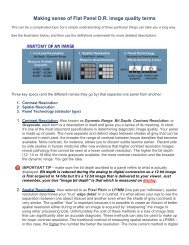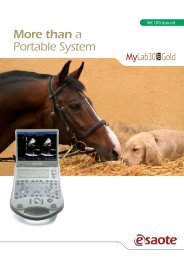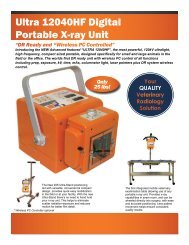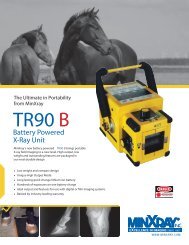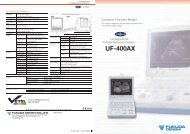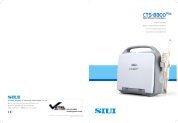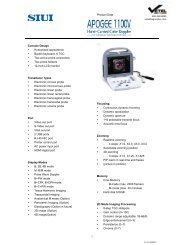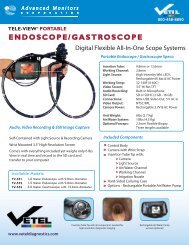to learn more about Thermal Imaging - Vetel Diagnostics
to learn more about Thermal Imaging - Vetel Diagnostics
to learn more about Thermal Imaging - Vetel Diagnostics
You also want an ePaper? Increase the reach of your titles
YUMPU automatically turns print PDFs into web optimized ePapers that Google loves.
About FLIR Systems<br />
With over 40 years experience and <strong>more</strong><br />
than 30,000 of its IR cameras in use, FLIR is<br />
the undisputed global leader in infrared<br />
systems. From industrial <strong>to</strong> military applications,<br />
thermography professionals have<br />
made FLIR their number one choice. No<br />
other company offers such a wide range of<br />
infrared cameras, software, service, training<br />
and support.<br />
FLIR’s ThermaCAM series of thermal imaging<br />
cameras have long set the standard for<br />
thermographic testing and analysis. Today<br />
they are the most widely used non-contact<br />
temperature measurement infrared cameras<br />
in the world.<br />
The Global Leaders in Infrared Cameras<br />
FLIR Systems, Bos<strong>to</strong>n<br />
Americas Thermography Center<br />
16 Esquire Rd.<br />
North Billerica, MA 01862<br />
1-800-464-6372<br />
www.flirthermography.com<br />
Natanya Nieman DVM<br />
Resident Veterinarian<br />
WinStar Farm LLC, Versailles, KY<br />
WinStar Farm uses Flir thermal imagingfor routine<br />
moni<strong>to</strong>ring of thier thoroughbred racing stable<br />
INFRARED SUCCESS STORIES<br />
Identifying the Causes of Diminished<br />
Performance in Equine Practice<br />
Jim Waldsmith , DVM, The Equine Center<br />
Many horses are presented <strong>to</strong> our practice with a request <strong>to</strong><br />
define subtle changes in the horse's gait which are believed<br />
<strong>to</strong> be associated with a decrease in the level of the horse's<br />
athletic ability.<br />
On clinical exam these horses are many times found <strong>to</strong> be<br />
"body sore" resenting flexion and palpation in several areas<br />
of their body. The lameness has not progressed <strong>to</strong> a head<br />
bob or hip hike that can be blocked, yet the owner or trainer<br />
is concerned that stress or injury exists that will effect the<br />
horse's future performance.<br />
In many of these cases the areas of pain and inflammation<br />
are difficult <strong>to</strong> define and document clinically, and the use<br />
of systemic anti-inflamma<strong>to</strong>ry medication is considered.<br />
The risk in this therapeutic scenario is that symp<strong>to</strong>ms may<br />
be masked, and the source(s) of the diminished performance<br />
remain unknown potentially leading <strong>to</strong> subsequent breakdown<br />
in the horse.<br />
After a complete clinical exam we find thermal imaging<br />
allows a quick and noninvasive assessment of the entire<br />
horse's body. Frequently areas of hoof imbalance, joint<br />
inflammation and abnormal tack wear can all be quickly<br />
identified. By simultaneously identifying and treating all<br />
areas of abnormality and inflammation the horse's athleticism<br />
is improved and risk of further injury diminished.<br />
We have found this pro<strong>to</strong>col <strong>to</strong> be very rewarding in<br />
our practice producing both client satisfaction and<br />
improvement in the athletic health of our equine patients.<br />
The Use of Thermography<br />
in Equine Medicine<br />
Tracy Turner , DVM, MS, Diplomate ACVS<br />
In equine practice, thermography can detect inflamma<strong>to</strong>ry<br />
changes well in advance of other modalities, many times up<br />
<strong>to</strong> two weeks prior <strong>to</strong> the onset of clinical lameness.<br />
With tendonitis, a detectable rise in temperature occurs<br />
prior <strong>to</strong> evidence of pain and swelling. As tendons heal,<br />
temperatures become <strong>more</strong> uniform but remain elevated,<br />
meaning thermal changes correlate well <strong>to</strong> structural<br />
reorganization. In cases of capsulitis/synovitis, as the joint<br />
becomes inflamed, the thermal pattern reveals an oval<br />
area of inflammation just over the joint.<br />
A particularly valuable use of Thermography is in detecting<br />
muscle injury. In addition <strong>to</strong> locating inflammation within a<br />
muscle or muscle group, atrophy can be detected before it<br />
is clinically apparent, presenting as areas of consistent<br />
decreased circulation and regional cooling when compared<br />
<strong>to</strong> the opposite side. Likewise, nerve injury due <strong>to</strong> direct<br />
trauma, secondary injury, or any disease that can affect blood<br />
flow can also be visualized with thermography.<br />
The uses in equine practice are endless:<br />
• Pre-purchase examinations,<br />
• Saddle fit,<br />
• A training aid <strong>to</strong> avoid injury<br />
(e.g., detecting hot shins before they buck),<br />
• Hoof balance and concussion injuries<br />
• Laminitis detection, and other foot diseases.<br />
• Capsulitis /synovitis in joints,<br />
• Tendonitis, (following tendon healing after injury),<br />
• Detecting muscle injury, atrophy and strain<br />
• Circula<strong>to</strong>ry changes before and after exercise.<br />
By utilizing <strong>Thermal</strong> <strong>Imaging</strong>, on a regular basis, in my<br />
clinical practice I find I am <strong>more</strong> able <strong>to</strong> efficiently and<br />
effectively locate both clinical and sub-clinical disease.<br />
Jim Waldsmith<br />
DVM, The Equine Center<br />
Tracy Turner<br />
DVM, MS, Diplomate ACVS<br />
"Thermography tells the<br />
practitioner what he didn't<br />
know he didn't know."<br />
For Veterinary <strong>Thermal</strong> <strong>Imaging</strong> call<br />
1 800 458-8890<br />
or visit veteldiagnostics.com



